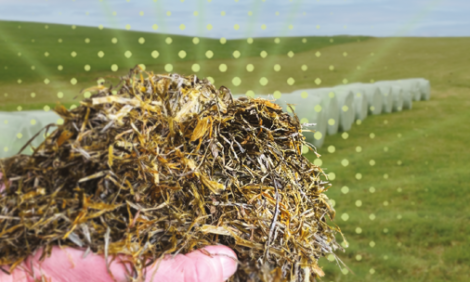



Focus on Forage: Hay Strategies
Good hay needs to be timed well on the right day to offer a nutritious fodder which can benefit your farm. Ohio expert Rory Lewandowski covers how.Mr Lewandowksi writes that the first sign of seed heads are a sure time to start thinking about cutting, as heads mean higher fibre and with increasing fiber content, quality of feed decreases.
This means that livestock producers who need high quality forage, dairy producers for example, now have the added pressure of juggling crop planting decisions with forage harvesting decisions when the sun finally shines and the soil dries enough to get machinery on it, writes Rory.
Forage Can Show a Quick Decline
Recently, Ohio State University Extension forage specialist Mark Sulc wrote: "A timely first and second cutting is critical for high quality forage. Fiber accumulates faster in the first two growth cycles in May and June than it does later in the summer."
In the May issue of "Forage News" from the University of Kentucky, the authors provided an example of how quickly forage quality can decline in a first harvest forage. They used a study that looked at the effect of stage of maturity of fescue hay on quality and animal performance.
Measurements were taken at the boot stage on May 3, the early bloom stage on May 14 and the early milk seed formation stage on May 25. Crude protein declined from 14 per cent on May 3 to 10 per cent on May 14 to 7.5 per cent on May 25. Percent digestibility went from 68 to 66 to 56 per cent over the same time period. The impact of forage quality on animal performance was measured in terms of pounds of gain per day. The May 3 hay produced 1.4 pounds of gain/day, the May 14 hay 0.97 pounds/day and the May 25 hay 0.42 pounds/day.
The Effect of Moisture
Rory writes that, in addition to quality losses associated with forage maturation, there are losses associated with trying to dry forage down to baling moisture. Dry hay production requires that forage is baled at the correct moisture.
Those moisture guidelines are: small square bales at 18-20 per cent , large round bales at 15 per cent and large rectangle bales at 13-15 per cent . It is difficult to dry cut forage on wet soil and weather forecasts at this time of year often include the chance of rain that limits drying time. A one inch rain on forage that is approaching dry hay moisture but still too wet to bale can result in dry matter losses of 8 to 17 per cent , a crude protein loss of almost 2 percentage units, a loss of total digestible nutrients (TDN) of 7 percent and an increase in NDF fiber of approximately 6 percentage units.
Is Time of the Essence?
What are some strategies that can be used to get hay cut, harvested and off the field sooner to minimize losses? Consider cutting a little higher. The increased stubble height can help to keep the cut forage off the wet soil. Keep swath widths as wide as possible to speed drying. For dry hay production systems consider the use of a preservative.
Preservatives allow forage to be baled at higher moisture content, saving some hours that can make the difference between a crop getting rained on or harvested and stored without rain. The most effective preservatives are propionic acid based. They work best between moisture levels of 20 to 25 per cent . Other important factors for success include using enough product and getting uniform application on the forage as it is running through the baler.
Another strategy that is useful when drying time is limited is to consider the option of baleage. Baleage involves harvest when the cut forage has wilted but is still high in moisture; in the 45 to 60 per cent moisture range or 40 to 55 per cent dry matter.
In order for this to be successful the forage must be baled and wrapped in plastic to create an anaerobic environment where an ensiling process can occur. Anaerobic microorganisms will ferment some of the forage carbohydrates to lactic acid which inhibits the growth of forage spoiling organisms and preserves the quality of the forage.
Key factors to baleage production include baling at an optimum moisture of 50 per cent , making tight bales to exclude oxygen pockets, wrapping the bales in plastic within 12 hours of baling (immediately after baling is best) and providing enough plastic thickness to keep out air and provide an anaerobic environment. In general, at least 4 wraps of 1.5 mil plastic is recommended.
Testing Moisture Content
Throughout this article moisture content has been mentioned numerous times as an important factor in hay production. Certainly years of experience are useful in gauging forage moisture but if you really need to know forage moisture the microwave oven method is still one of the quickest, least expensive and easiest methods available. It involves grabbing a representative forage sample and chopping or cutting it into short lengths of less than 1 inch.
Next weigh out 100 to 200 grams (3.5 to 7.0 ounces) and spread it out in a microwave safe plate. Heat the sample for a minute and re-weigh. Shake and re-distribute the sample on the plate and heat for another 45 seconds to one minute. Repeat this heating and re-weighing process until the sample stabilizes and does not decrease in weight between cycles. Be careful as you approach the end point to avoid charring or burning the sample and adjust heating times accordingly. The moisture content is equal to the beginning weight minus the end weight divided by the beginning weight.


